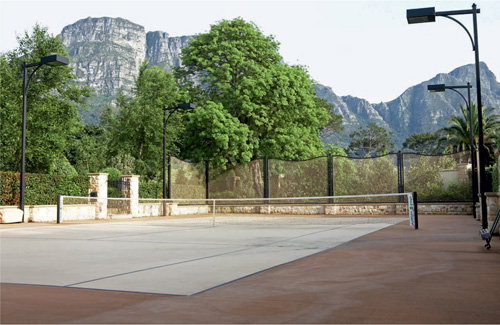


Contents

Nicolas foreword

Designing a way of living that is a unique expression of ourselves is all about creating beautiful spaces that delight the senses and touch the soul. And weve come to realise that four solid walls need not define this. Transforming the nooks and forgotten corners of a garden into places of beauty has moved way beyond the practical. The garden is an extension of the house. Or is it that the house is an extension of the garden?
The idea for a book on gardens came to me while travelling around the country photographing houses for my previous book, Beautiful Homes of South Africa. With this project I reaffirmed the importance of flow between an interior and its surrounds. Just think how many of the worlds top garden designers began their careers as interior decorators. As the years went by there was a need for fresh creative ideas, and these designers came to appreciate the importance of enhancing their beautiful room settings by extending them into the surrounds. David Hicks, doyen of both interior and exterior spaces, led the way, greatly inspiring many other illustrious creative personalities. Some of his trendsetting work in South Africa appears in these pages.
Since starting this book, I have met so many extraordinarily gifted garden designers, landscapers and green-fingered natural gardening experts, and have gained a new-found respect for the earth, plants and trees. Unlike decorating a room, which is finite, for a number of years at least, the garden demands constant nurturing. It is a living, breathing art form that must be cared for every day a singularly pleasurable pastime. These designers also work with the elements, maintaining a level of eco-awareness with the inclusion of indigenous and water-wise plants wherever suitable, to ensure an ecological sensitivity so that we may protect our precious earth.
My aim with Beautiful Outdoors is to embrace the stylish individuality and confidence of garden owners, some of whom shun conformity and convention, steering away from the cloned design trends that tend to be repeated in South African gardens. Instead, these individuals do it their way, with originality and flair. Some spaces have been styled by human hands, in others softly moulded edges and curves have yielded to natures dictates.
A few of the gardens form part of an owners private hotel or wellness spa, as opposed to a personal home, but universal to all the gardens is the passion of the owners for the earth and nature, and their ability to push boundaries yet maintain good principles of colour, form, structure and design. You have to love your garden, states one homeowner. Like a child, you have to be patient with your garden, nurture it and occasionally discipline it, claims another.
As the owners talk about their gardens, you discover the patience and level of acceptance required. Plants may not thrive, the reality of the original vision may disappoint, unpredictable weather may do huge damage. But they never give up.
I am more than grateful to Plascon Paints for its continued confidence in and loyal support of my projects. I hope the brilliant colours in the photographs do justice to the range of paint colours for which Plascon is justifiably famous.
Intentionally veering away from horticultural input, as this is not my line of expertise, I have left this to horticulturist Sandy Munro, who has expertly identified trees and shrubs. Thank you, Sandy.
My design philosophy has remained constant for the past two decades of my creative career: There is perfection in imperfection, and Dont change it; perfect it. So my brief to my photographers was to bring in what was around us, just as nature intended, to avoid posed or contrived settings, to use only natural light and to capture the mood of the moment. Should a breeze unexpectedly blow, or a cloud drift by, let it be.

Brave heart

The position and proportions of the pool were vital to the overall balance of the garden. Situated on the upper terrace, close to both the house and the conservatory, the sound of spray from raised water jets is relaxing with summer evening sundowners. The pool surround is Naboomspruit sandstone, while the water jets are mounted on two stainless steel pipes running beneath the sandstone, and operate from their own pump.

The art studio and guest cottage in the garden, designed to replicate an orangery, are situated next to a lemon walkway. Tucked away on the other side is the barn, where Sharland keeps her gardening materials. An imposing pin oak stands guard over a pair of life-size bronze bushbuck by sculptor David Tomlinson.

Two life-size bronze cheetahs by David Tomlinson are positioned on the lower terrace, as the focal point between two contained beds of perfectly clipped lavender (Lavandula angustifolia). In the background, a simple garden pavilion beckons as a shady resting place. The garden enjoys ninety per cent full sun.

One of a pair of bespoke urns in light ochre that have been placed in matching ponds on concrete plinths. The plinths are submerged below water level to create the illusion of floating pots. The ponds themselves are painted black and edged with black slate.

The 3.5-metre-high concrete retaining wall clad in sandstone, with the conservatory beyond, on the upper level.

As the owners are enthusiastic tennis players, the tennis court is an important feature of the garden that also needs to be aesthetically pleasing. Instead of standard court fencing, Sharland specified a sandy colour to blend in with the retaining wall. She has also used this colour for the tennis court surface and the rope weave of the nets.
The back wall of the court forms part of the propertys retaining wall. To avoid the potential hazard of the ball bouncing back, Sharland designed a net that can be pulled across, like a curtain. This runs easily on a track, using yachting materials sourced by Gavin. The lights are replicas of English streetlights.
Next page






















